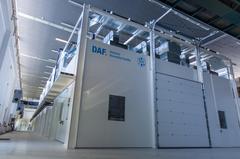URL: https://www.desy.de/news/news_search/index_eng.html
Breadcrumb Navigation
DESY News: Detector Assembly Facility now fully operational
News
News from the DESY research centre
Detector Assembly Facility now fully operational
There’s not a speck of dust in sight in these rooms: DESY's Detector Assembly Facility (DAF) was officially opened this month. In the Detector Assembly Facility, DESY and its national and international partners are building and testing central and extremely complex components for the large particle detectors ALTAS and CMS at CERN in Geneva. The DAF consists of two buildings, each with ultra-modern clean rooms. One building has been in operation since last year, the other has now been put into operation as part of the meeting of the DESY Scientific Council.

High-tech in a historic setting – DESY's Detector Assembly Facility is complete. Image: DESY
While several thousand high-precision silicon detectors are developed, built and tested in one of the clean rooms, they are assembled into complete detector disks in the other, the endcaps of the so-called silicon trackers. In a few years, these detector components will be part of the upgraded ATLAS and CMS experiments to search for new particles, dark matter and other unexplored phenomena.
During the peak phase of production, the DAF will produce more than 3000 modules for the two detectors in about 16 months. Up to 20 people will be involved in the various production steps, from the incoming inspection of the sensors at the test stations or bonding the module components and connecting the electrical contacts with 20-μm-thin wires with the thin wire bonder to the final inspection and calibration of the finished modules.
The final assembly of the more than two-metre end caps with about 30 square metres of silicon detectors for ATLAS and CMS takes place in DESY’s historic Hall 1, which was equipped with a huge clean room.
After final assembly and extensive testing, the two endcaps will be transported to the LHC experiments at CERN in Geneva in a few years' time.



